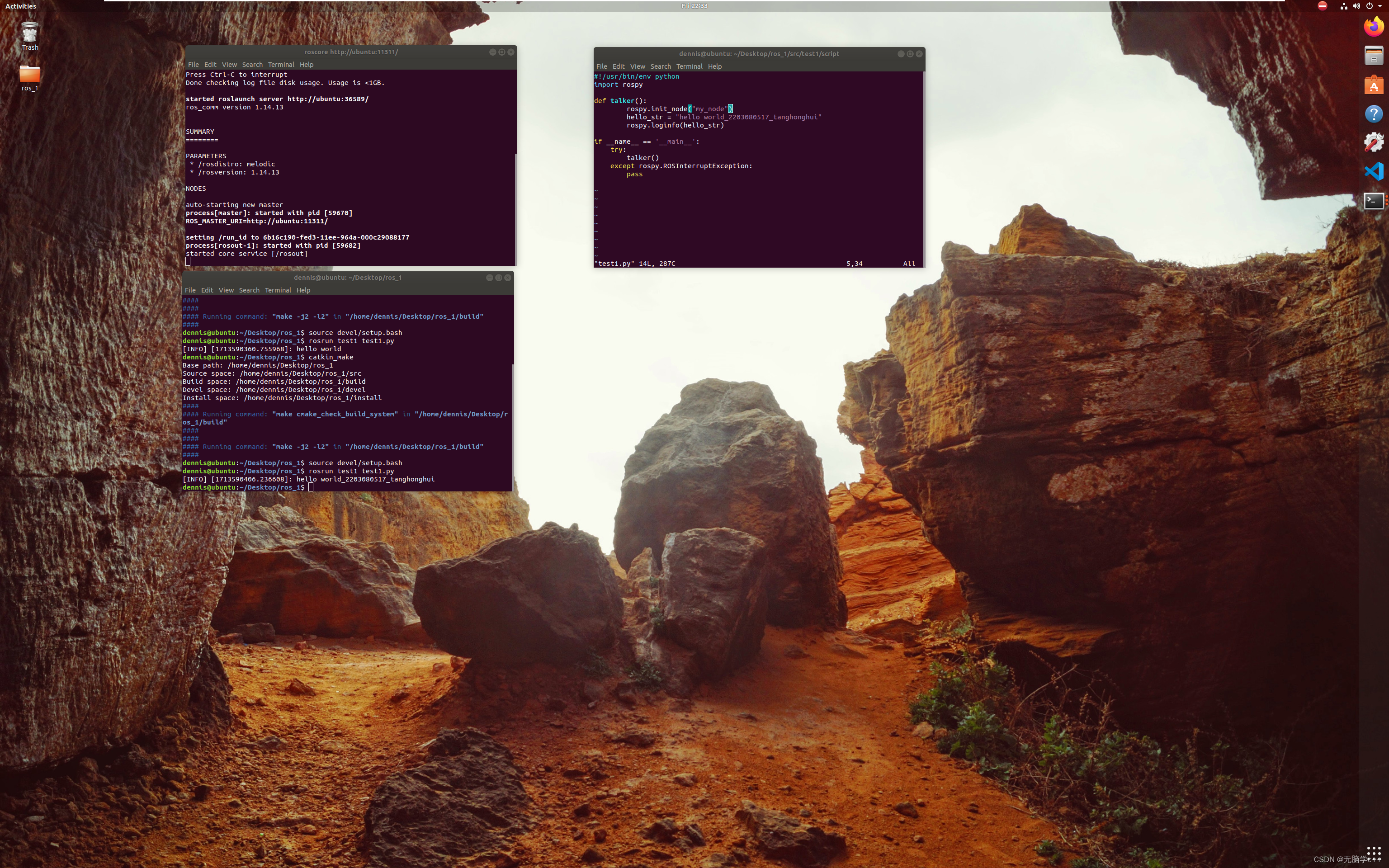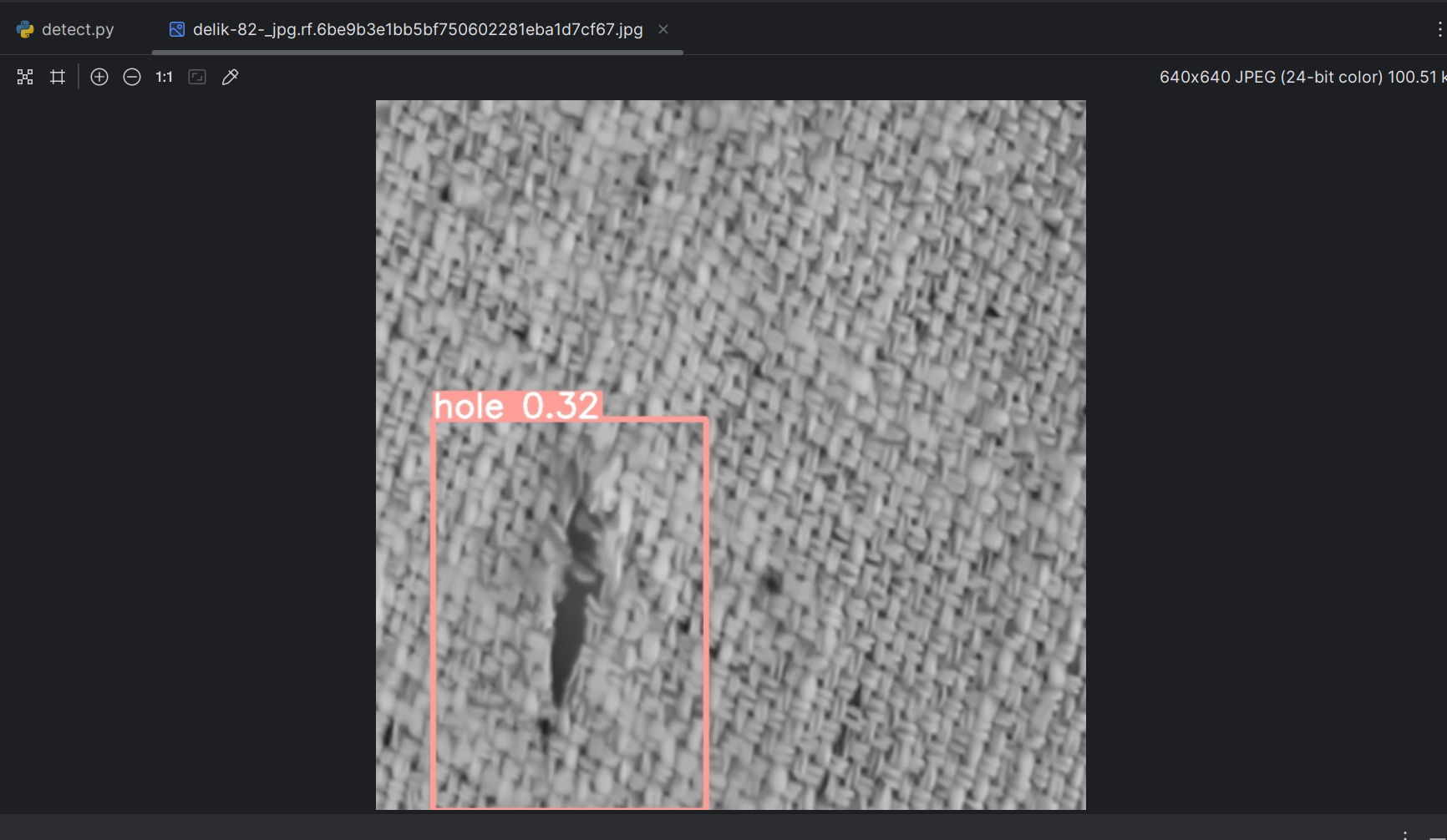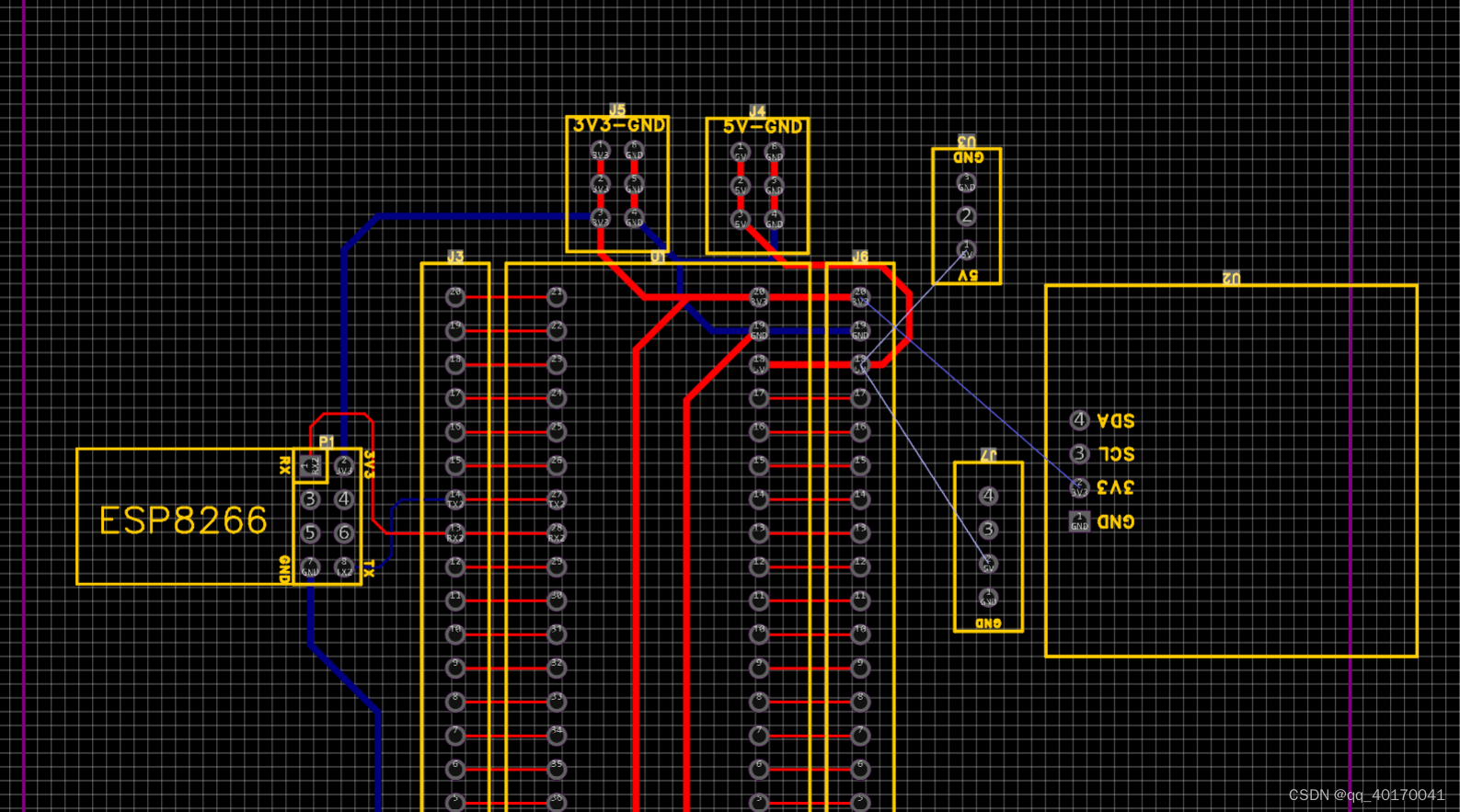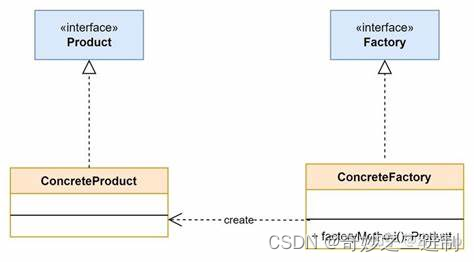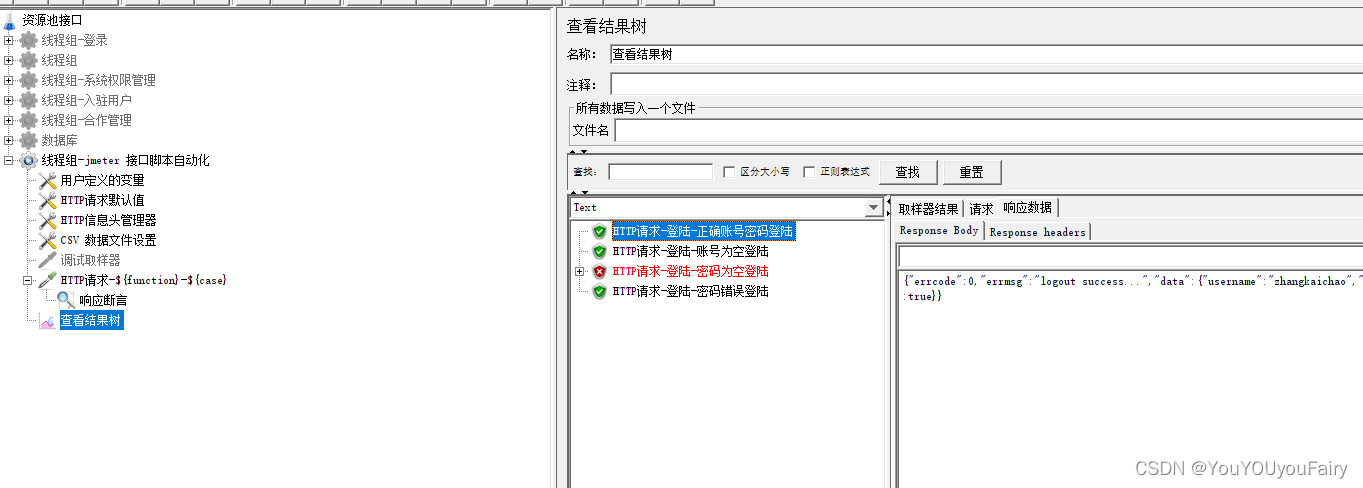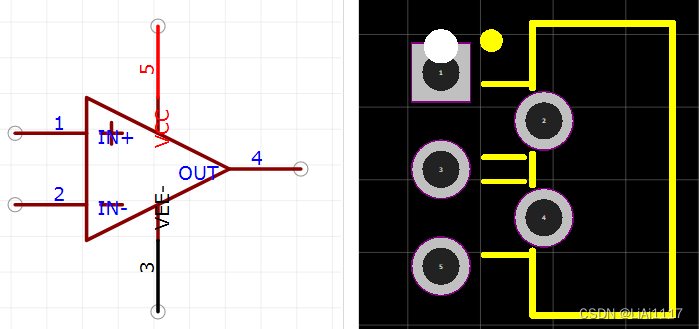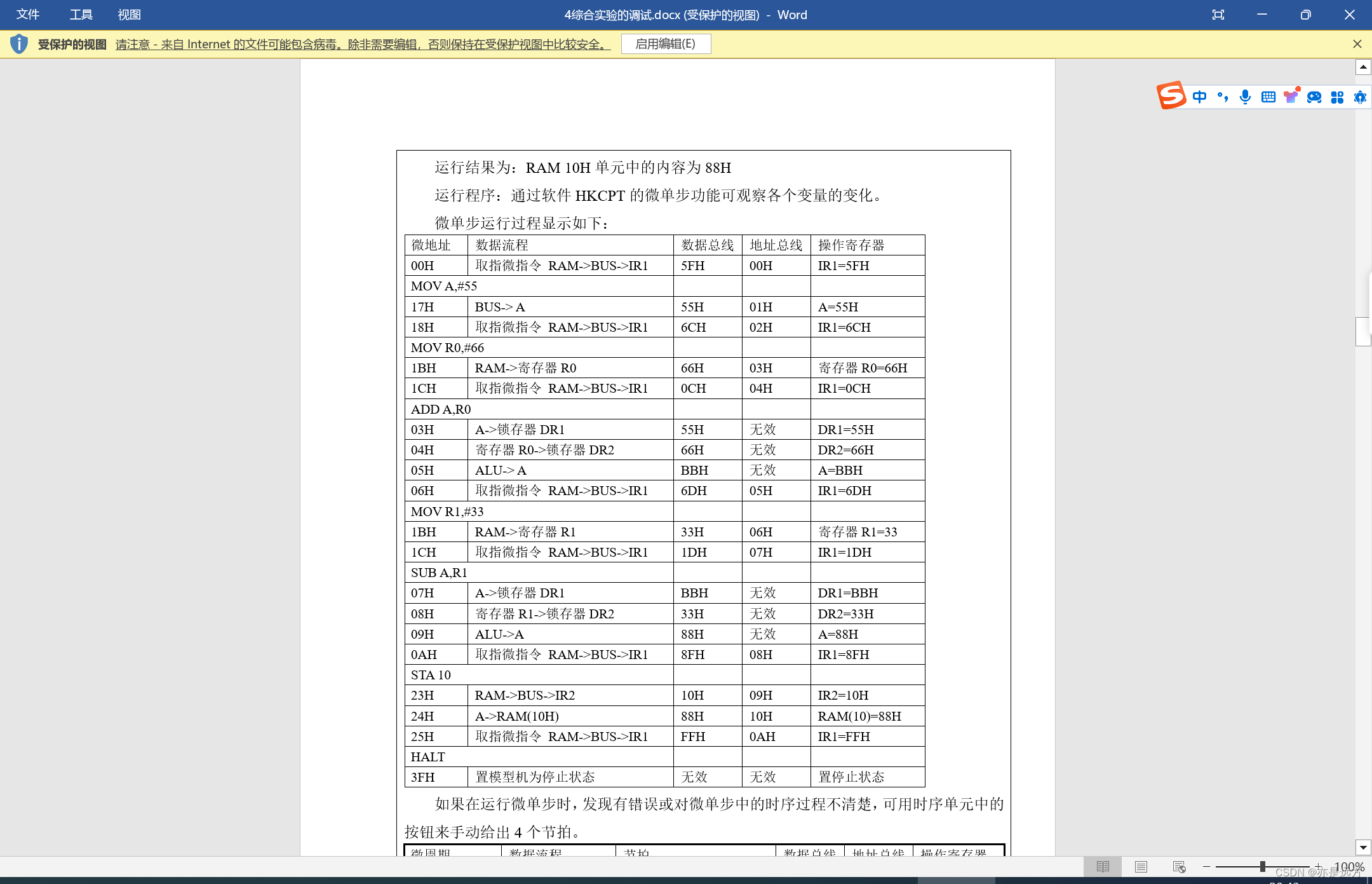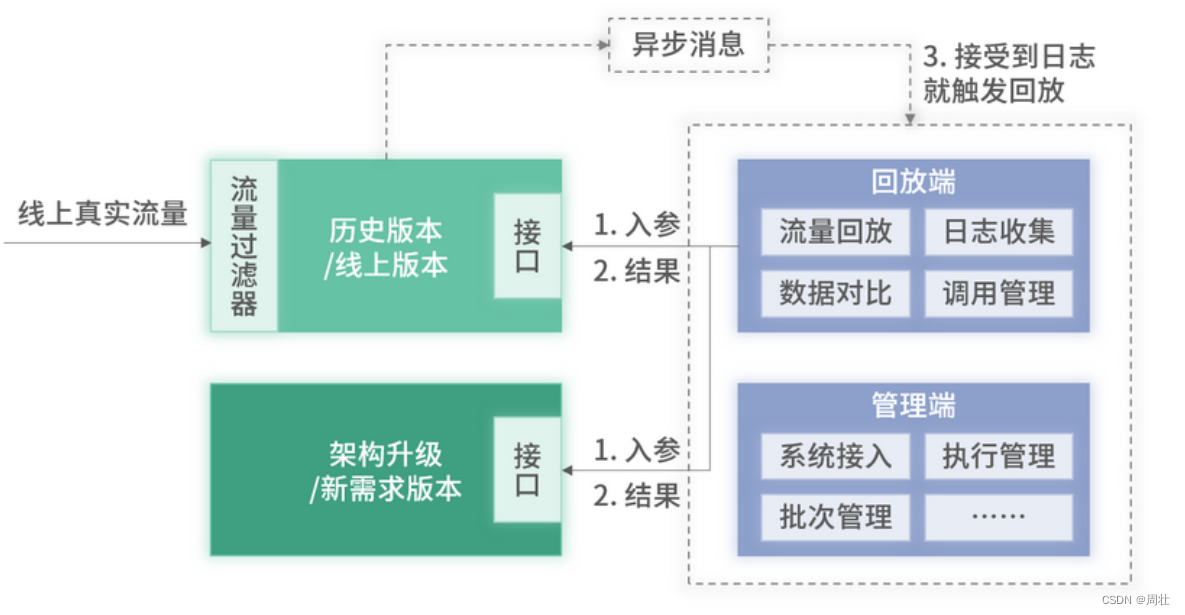一、同步概念
同步即协同步调,按预定的先后次序运行。
协同步调,对公共区域数据【按序】访问,防止数据混乱,产生与时间有关的错误。
数据混乱的原因:
- 资源共享(独享资源则不会)
- 调度随机(意味着数据访问会出现竞争)
- 线程间缺乏必要同步机制
二、锁
1. 互斥锁
linux中提供一把互斥锁mutex(也称之为互斥量)。
建议锁!对公共数据进行保护。所有线程【应该】在访问公共数据前先拿锁再访问。但锁本身不具备强制性。
数据共享导致的混乱pthrd_shared.c:
#include <stdio.h>
#include <string.h>
#include <pthread.h>
#include <stdlib.h>
#include <unistd.h>
//子线程
void *tfn(void *arg)
{
srand(time(NULL));
while(1)
{
printf("hello ");
sleep(rand() % 3); //模拟长时间操作共享资源,导致cpu易主,产生与时间有关的错误
printf("world\n");
sleep(rand() % 3);
}
return NULL;
}
int main(void)
{
pthread_t tid;
srand(time(NULL));
// 创建线程
pthread_create(&tid,NULL,tfn,NULL);
while(1)
{
printf("HELLO ");
sleep(rand() % 3);
printf("WORLD\n");
sleep(rand() % 3);
}
//回收线程
pthread_join(tid,NULL);
return 0;
}
输出为:
HELLO hello WORLD
world
hello HELLO WORLD
world
HELLO hello WORLD
world
hello HELLO world
hello WORLD
world
HELLO hello world
pthread_mutex_函数
初始化:
int pthread_mutex_init(pthread_mutex_t *restrict mutex,const pthread_mutexattr_t *restrict attr);销毁:
int pthread_mutex_destroylock(pthread_mutex_t *mutex);上锁:
int pthread_mutex_lock(pthread_mutex_t *mutex);try锁:
int pthread_mutex_trylock(pthread_mutex_t *mutex);解锁:
int pthread_mutex_unlock(pthread_mutex_t *mutex);以上函数的返回值都是:成功返回0,失败返回错误号;
restrict关键字
用来限定指针变量。被该关键字限定的指针变量所指向的内存操作,必须由本指针完成。
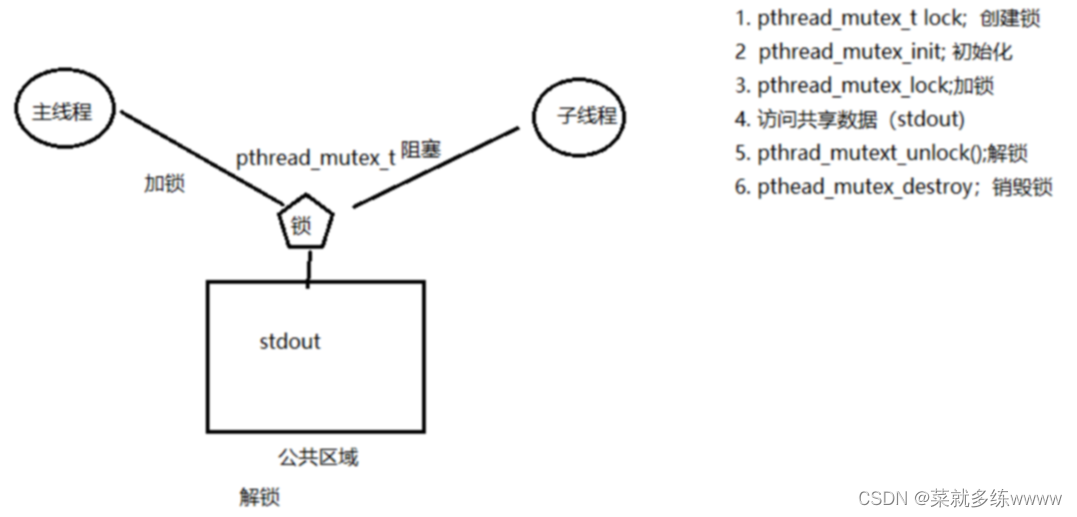
使用mutex(互斥量、互斥锁)一般步骤:
- pthread_mutex_t lock;创建锁
- pthread_mutex_init;初始化
- pthread_mutex_lock;加锁
- 访问共享数据
- pthread_mutex_unlock;解锁
- pthread_mutex_destroy;销毁锁
初始化互斥量:
pthread_mutex_t mutex;
1. 动态初始化:pthread_mutex_init(&mutex, NULL);
2. 静态初始化:pthread_mutex_t mutex = PTHREAD_MUTEX_INITIALIZER;
注意事项:
1. 尽量保证锁的粒度,越小越好。(访间共享数据前,加锁。访问结束【立即】解锁。)
2. 互斥锁:本质是结构体。我们可以看成整数。初值为1。(pthread_mutex_init(函数调用成功。))3. 加锁:--操作,阻塞线程。
4. 解锁:++操作,换醒阻塞在锁上的线程。
5. try锁:尝试加锁,成功--。失败,返回。同时设置错误号EBUSY
修改上面pthrd_shared.c的代码,使用锁实现互斥访问共享区:
#include <stdio.h>
#include <string.h>
#include <pthread.h>
#include <stdlib.h>
#include <unistd.h>
pthread_mutex_t mutex;//定义一把互斥锁
//子线程
void *tfn(void *arg)
{
srand(time(NULL));
while(1)
{
pthread_mutex_lock(&mutex);//加锁
printf("hello ");
sleep(rand() % 3);//模拟长时间操作共享资源,导致cpu易主,产生与时间有关的错误
printf("world\n");
pthread_mutex_unlock(&mutex);//解锁
sleep(rand() % 3);
}
return NULL;
}
int main(void)
{
pthread_t tid;
srand(time(NULL));
int ret = pthread_mutex_init(&mutex,NULL);//初始化互斥锁
if (ret != 0)
{
fprintf(stderr,"mutex init error:%s\n",strerror(ret));
exit(1);
}
// 创建线程
pthread_create(&tid,NULL,tfn,NULL);
while(1)
{
pthread_mutex_lock(&mutex);//加锁
printf("HELLO ");
sleep(rand() % 3);
printf("WORLD\n");
pthread_mutex_unlock(&mutex);//解锁
sleep(rand() % 3);
}
//回收线程
pthread_join(tid,NULL);
pthread_mutex_destroy(&mutex);//销毁互斥锁
return 0;
}
输出为:
HELLO WORLD
hello world
HELLO WORLD
hello world
HELLO WORLD
hello world
2. 死锁:对锁使用不恰当导致的现象
1. 对一个锁反复lock。
2. 两个线程,各自持有一把锁,请求另一把。

情况 1:对一个锁反复 lock
#include <stdio.h>
#include <stdlib.h>
#include <pthread.h>
pthread_mutex_t mutex;
void *lockTwice(void *arg)
{
pthread_mutex_lock(&mutex); // 第一次获取锁
printf("Lock acquired once.\n");
pthread_mutex_lock(&mutex); // 尝试再次获取同一个锁,导致死锁
printf("Lock acquired twice.\n");
pthread_mutex_unlock(&mutex);
pthread_mutex_unlock(&mutex);
return NULL;
}
int main()
{
pthread_t tid;
pthread_mutex_init(&mutex, NULL);
pthread_create(&tid, NULL, lockTwice, NULL);
pthread_join(tid, NULL);
pthread_mutex_destroy(&mutex);
return 0;
}
在这个示例中,我们尝试在同一线程中两次锁定同一个互斥锁。因为 pthread_mutex_t 默认是非递归的,第二次尝试锁定会导致线程阻塞,从而产生死锁 。
情况 2:两个线程,各自持有一把锁,请求另一把
#include <stdio.h>
#include <stdlib.h>
#include <pthread.h>
pthread_mutex_t lock1, lock2;
void *thread1Func(void *arg)
{
pthread_mutex_lock(&lock1);
printf("Thread 1 acquired lock 1\n");
sleep(1); // 增加死锁发生的可能性
pthread_mutex_lock(&lock2);
printf("Thread 1 acquired lock 2\n");
pthread_mutex_unlock(&lock2);
pthread_mutex_unlock(&lock1);
return NULL;
}
void *thread2Func(void *arg) {
pthread_mutex_lock(&lock2);
printf("Thread 2 acquired lock 2\n");
sleep(1); // 增加死锁发生的可能性
pthread_mutex_lock(&lock1);
printf("Thread 2 acquired lock 1\n");
pthread_mutex_unlock(&lock1);
pthread_mutex_unlock(&lock2);
return NULL;
}
int main()
{
pthread_t t1, t2;
pthread_mutex_init(&lock1, NULL);
pthread_mutex_init(&lock2, NULL);
pthread_create(&t1, NULL, thread1Func, NULL);
pthread_create(&t2, NULL, thread2Func, NULL);
pthread_join(t1, NULL);
pthread_join(t2, NULL);
pthread_mutex_destroy(&lock1);
pthread_mutex_destroy(&lock2);
return 0;
}这个示例中,thread1Func 先锁定 lock1,然后尝试锁定 lock2。同时,thread2Func 先锁定 lock2,然后尝试锁定 lock1。这种交叉锁定容易导致死锁,因为每个线程都在等待对方释放另一把锁。
3. 读写锁rwlock:
pthread_rwlock_函数
pthread_rwlock_t rwlock; 用于定义一个读写锁变量
pthread_rwlock_init(&rwlock, NULL);
pthread_rwlock_rdlock(&rwlock); tryrdlock
pthread_rwlock_wrlock(&rwlock); trywrlock
pthread_rwlock_unlock(&rwlock);
pthread_rwlock_destroy(&rwlock);
参数与互斥锁类似
以上函数的返回值都是:成功返回0,失败返回错误号
与互斥量类似,但读写锁允许更高的并行性。其特性为:写独占,读共享
- 锁只有一把。以读方式给数据加锁------读锁。以写方式给数据加锁------写锁。
- 读共享,写独占。
- 写锁优先级高。
- 相较于互斥量而言,当读线程多的时候,提高访问效率
读写锁是“读模式加锁”时, 既有试图以写模式加锁的线程,也有试图以读模式加锁的线程。那么读写锁会阻塞随后的读模式锁请求。优先满足写模式锁。读锁、写锁并行阻塞,写锁优先级高
代码示例验证写锁优先级高:
#include<stdio.h>
#include<unistd.h>
#include<pthread.h>
int counter;
pthread_rwlock_t rwlock;//全局的读写锁
//3个线程不定时写统一全局资源,5个线程不定时读统一全局资源
void *th_write(void *arg)
{
int t;
int i = (int)arg;
while (1)
{
pthread_rwlock_wrlock(&rwlock);//以写模式加锁,写独占
t = counter;
usleep(1000);
printf("===write %d: %lu: counter=%d ++counter=%d\n",i,pthread_self(),t,++counter);
pthread_rwlock_unlock(&rwlock);
usleep(10000);
}
return NULL;
}
void *th_read(void *arg)
{
int i = (int)arg;
while (1)
{
pthread_rwlock_rdlock(&rwlock);//读锁共享
printf("-----read %d: %lu: %d\n",i,pthread_self(),counter);
pthread_rwlock_unlock(&rwlock);
usleep(2000);
}
return NULL;
}
int main(void)
{
int i;
pthread_t tid[8];
pthread_rwlock_init(&rwlock,NULL);
for (i = 0;i < 3;i++)
pthread_create(&tid[i],NULL,th_write,(void*)i);
for (i = 0; i < 5; i++)
pthread_create(&tid[i+3],NULL,th_read,(void*)i);
for (i = 0;i< 8; i++)
pthread_join(tid[i],NULL);
pthread_rwlock_destroy(&rwlock);
return 0;
}
三、条件变量
条件变量本身不是锁!但它也可以造成线程阻塞,通常与互斥锁配合使用。
主要应用函数:
pthread_cond_init函数 初始化一个条件变量
pthread_cond_destroy函数 销毁一个条件变量
pthread_cond_wait函数 阻塞等待一个条件变量
pthread_cond_timedwait函数 限时等待一个条件变量
pthread_cond_signal函数 唤醒至少一个阻塞在条件变量上的线程
pthread_cond_broadcast函数 唤醒全部阻塞在条件变量上的线程
参数与互斥锁类似
以上6 个函数的返回值都是:成功返回0, 失败直接返回错误号。
pthread_cond_t类型 用于定义条件变量
pthread_cond_t cond;
pthread_cond_init函数
int pthread_cond_init(pthread_cond_t *restrict cond, const pthread_condattr_t *restrict attr);
参2:attr表条件变量属性,通常为默认值,传NULL即可
也可以使用静态初始化的方法,初始化条件变量:
pthread_cond_t cond = PTHREAD_COND_INITIALIZER;
pthread_cond_wait函数
pthread_cond_wait(&cond, &mutex);
阻塞等待一个条件变量
作用:
- 阻塞等待条件变量cond(参1)满足
- 解锁已经掌握的互斥锁【解锁互斥量】(相当于 pthread_mutex_unlock(&mutex)),1 2两步为一个原子操作(一起执行,不可分割)
- 当被唤醒,pthread_cond_wait函数返回时,解除阻塞并重新申请获取互斥锁,即重新加锁(相当于pthread_mutex_lock(&mutex);)

1. 当调用pthread_cond_wait函数时,它在阻塞等待条件满足时,会解锁
2. 当条件满足后,重新加锁
3. pthread_cond_signal()、pthread_cond_broadcast()函数会发送条件满足的信号
4. 通过pthread_cond_timewait()函数来限时等待一个条件变量
条件变量的生产者消费者模型分析:
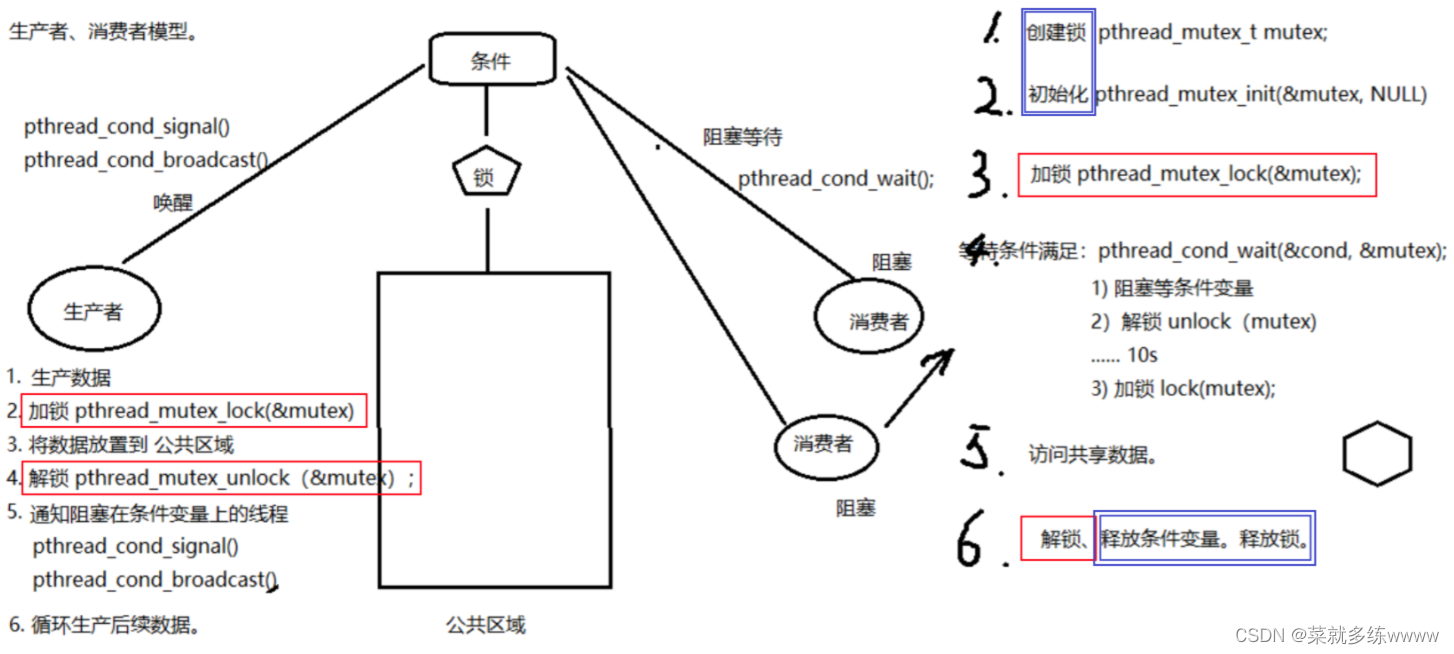
条件变量实现生产者消费者代码:
#include<stdio.h>
#include<stdlib.h>
#include<string.h>
#include<unistd.h>
#include<errno.h>
#include<pthread.h>
void err_thread(int ret,char *str)
{
if (ret != 0)
{
fprintf(stderr,"%s:%d\n",str,strerror(str));
pthread_exit(NULL);
}
}
//创建共享数据
struct msg
{
//struct msg 是一个结构体,包含至少两个字段:
//num(数据)和 next(指向链表中下一个节点的指针)
int num;
struct msg *next;
};
struct mas *head;
pthread_mutex_t mutex = PTHREAD_MUTEX_INITIALIZER;//定义并且初始化一个互斥量
pthread_cond_t has_data = PTHREAD_COND_INITIALIZER;//定义并且初始化一个条件变量
void *producer(void *arg)
{
while(1){ //添加循环多次生产
struct msg *mp = malloc(sizeof(struct msg));//为新的数据项动态分配内存
mp->num = rand() % 1000 + 1;//模拟生产一个数据
printf("---produce %d\n",mp->num);
pthread_mutex_lock(&mutex);//加锁互斥量
mp->next = head;//头插法插入链表,写公共区域
head = mp;
pthread_mutex_unlock(&mutex); //解锁互斥量
pthread_cond_signal(&has_data); //唤醒在阻塞条件变量has_data上的线程
sleep(rand() % 3);
}
return NULL;
}
void *consumer(void *arg)
{
while(1){
struct msg *mp;
pthread_mutex_lock(&mutex);//加锁互斥量
if (head == NULL)
{
pthread_cond_wait(&has_data,&mutex);//阻塞等待条件变量,解锁。pthread_connd_wait返回时,重新加锁mutex
}
mp = head;
head = mp->next;
pthread_mutex_unlock(&mutex);//解锁互斥量
printf("------consumer:%d\n",mp->num);
free(mp);
sleep(rand() % 3);
}
return NULL;
}
int main(int argc,char *argv[])
{
int ret;
pthread_t pid,cid;
srand(time(NULL));
ret = pthread_create(&pid,NULL,producer,NULL);
if (ret != 0)
{
err_thread(ret,"pthread_create producer error");//生产者
}
ret = pthread_create(&cid,NULL,consumer,NULL);
if (ret != 0)
{
err_thread(ret,"pthread_create consumer error");//消费者
}
pthread_join(pid,NULL);
pthread_join(cid,NULL);
return 0;
}
输出为:
---produce 330
------consumer id:139864563013376:330
---produce 839
------consumer id:139864554620672:839
---produce 126
------consumer id:139864554620672:126
多个消费者使用while做:
if (ret != 0)
{
err_thread(ret,"pthread_create consumer error");//消费者
}
复制多份创建消费者的代码,并且在consumer回调函数中将if (head == NULL)修改为while (head == NULL)。若未进行修改,则出现段错误
输出为:
---produce 783
---produce 284
---produce 115
---produce 203
------consumer id:139795136452352:203
------consumer id:139795144845056:115
---produce 199
------consumer id:139795153237760:199
------consumer id:139795153237760:284
------consumer id:139795136452352:783
条件变量signal注意事项:
pthread_cond_signal(): 唤醒阻塞在条件变量上的 (至少)一个线程。
pthread_cond_broadcast(): 唤醒阻塞在条件变量上的 所有线程。
四、信号量
- 应用于线程、进程间同步。
- 相当于 初始化值为 N 的互斥量。 N值,表示可以同时访问共享数据区的线程数
sem_函数:
sem_t sem;定义类型,本质是结构体int sem_init(sem_t *sem, int pshared, unsigned int value);
参数:
sem: 信号量
pshared: 0: 用于线程间同步
1: 用于进程间同步
value:N值。(指定同时访问的线程数)
sem_destroy();
sem_wait();一次调用,做一次-- 操作, 当信号量的值为 0 时,再次 -- 就会阻塞。(对比pthread_mutex_lock)
sem_trywait();
sem_timedwait();
sem_post();一次调用,做一次++ 操作,当信号量的值为 N 时, 再次 ++ 就会阻塞。(对比 pthread_mutex_unlock)
以上6 个函数的返回值都是:成功返回0, 失败返回-1,同时设置errno。
信号量的初值,决定了占用信号量的线程的个数
信号量实现的生产者消费者:
分析:
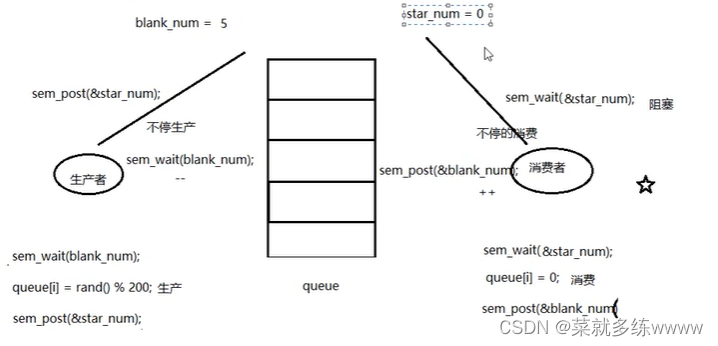
代码示例:
/*信号量实现 生产者 消费者问题*/
#include<stdio.h>
#include<stdlib.h>
#include<unistd.h>
#include<string.h>
#include<pthread.h>
#define NUM 5
int queue[NUM]; //全局数组实现环形队列
sem_t blank_number, product_number; //空格子信号量, 产品信号量
void *producer(void *arg)
{
int i = 0;
while (1)
{
sem_wait(&blank_number); //生产者将空格子数--,为0则阻塞等待
queue[i] = rand() % 1000 + 1; //生产一个产品
printf("----Produce---%d\n", queue[i]);
sem_post(&product_number); //将产品数++
i = (i+1) % NUM; //借助下标实现环形
sleep(rand()%1);
}
}
void *consumer(void *arg)
{
int i = 0;
while (1) {
sem_wait(&product_number); //消费者将产品数--,为0则阻塞等待
printf("-Consume---%d\n", queue[i]);
queue[i] = 0; //消费一个产品
sem_post(&blank_number); //消费掉以后,将空格子数++
i = (i+1) % NUM;
sleep(rand()%3);
}
}
int main(int argc, char *argv[])
{
sem_init(&blank_number, 0, NUM); //初始化空格子信号量为5, 线程间共享--0
sem_init(&product_number, 0, 0); //产品数为0
pthread_t pid, cid;
pthread_create(&pid, NULL, producer, NULL);
pthread_create(&cid, NULL, consumer, NULL);
pthread_join(pid, NULL);
pthread_join(cid, NULL);
sem_destroy(&blank_number);
sem_destroy(&product_number);
return 0;
} 条件变量和信号量实现生产者消费者模型掌握一个即可



